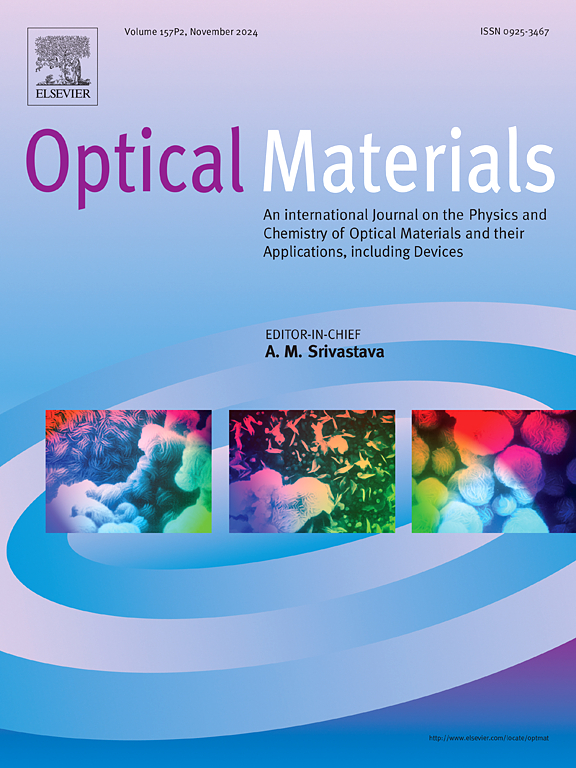The role of Ce3+ Co-doping in the luminescent enhancement of Bi3+ emission and Bi3+→Bi2+ conversion in LiLaP4O12 host
IF 3.8
3区 材料科学
Q2 MATERIALS SCIENCE, MULTIDISCIPLINARY
引用次数: 0
Abstract
This work investigates the luminescent versatility of the LiLa(1-x-y)BixCeyP4O12 system as a scintillator material capable of displaying emission in a range from the blue to the red region depending on the Ce3+ concentration. The LiLaP4O12 host has been proven to be useful as a scintillator material when doped with some rare earths and with bismuth ions. However, the process of bismuth valence change induced by X-rays, when inserted in the LiLaP4O12 matrix, is not known to date, as well as whether this can be controlled and used to enhance the luminescence emission. To determine the mechanism of interaction between the Ce3+ and Bi3+ ions in the LiLaP4O12 host, doped and co-doped samples were synthesized and investigated. Identification of crystalline phase was carried out with X-Ray Powder Diffraction. The luminescent properties were studied via photoluminescence emission and excitation using synchrotron radiation. Scintillator features were studied through radioluminescence emission spectrum. The results indicate that Ce3+ transfers either energy or electrons to Bi3+ when excited with UV (5.2 eV) or X-rays, respectively. In the first case, the overall white luminescence is improved, while in the latter, enhanced red luminescence from Bi2+ was observed, indicating the valence change of Bi ions, assisted by Ce co-dopant. A luminescent mechanism, based on the vacuum-referred binding energy model applied to the experimental data, was proposed to explain the Bi2+ emission, deepening the understanding of the Bi emission mechanism and opening the possibility of tailoring the Bi2+/Bi3+ proportion varying the Ce-co-doping concentration.
Ce3+ 共掺杂在 LiLaP4O12 宿主中 Bi3+ 发射和 Bi3+→Bi2+ 转化的发光增强中的作用
这项研究探讨了 LiLa(1-x-y)BixCeyP4O12 系统作为闪烁体材料的发光多功能性,它能够根据 Ce3+ 浓度的不同,在从蓝色到红色区域的范围内发光。事实证明,当掺杂一些稀土和铋离子时,LiLaP4O12 宿主可用作闪烁体材料。然而,迄今为止,人们还不知道铋离子插入 LiLaP4O12 基质后在 X 射线诱导下发生价态变化的过程,也不知道这种变化是否可以控制并用于增强发光发射。为了确定 Ce3+ 和 Bi3+ 离子在 LiLaP4O12 主体中的相互作用机制,我们合成并研究了掺杂和共掺杂样品。利用 X 射线粉末衍射技术对晶相进行了鉴定。利用同步辐射通过光致发光发射和激发研究了发光特性。通过辐射发光发射光谱研究了闪烁体的特征。结果表明,在紫外线(5.2 eV)或 X 射线的激发下,Ce3+ 会分别将能量或电子转移到 Bi3+。在前一种情况下,整体白色发光得到改善,而在后一种情况下,观察到来自 Bi2+ 的红色发光增强,这表明在 Ce 共掺杂剂的辅助下,Bi 离子的价态发生了变化。基于将真空参考结合能模型应用于实验数据,提出了一种发光机制来解释 Bi2+ 的发射,从而加深了对 Bi 发射机制的理解,并为改变 Ce 共掺杂浓度来定制 Bi2+/Bi3+ 比例提供了可能。
本文章由计算机程序翻译,如有差异,请以英文原文为准。
求助全文
约1分钟内获得全文
求助全文
来源期刊

Optical Materials
工程技术-材料科学:综合
CiteScore
6.60
自引率
12.80%
发文量
1265
审稿时长
38 days
期刊介绍:
Optical Materials has an open access mirror journal Optical Materials: X, sharing the same aims and scope, editorial team, submission system and rigorous peer review.
The purpose of Optical Materials is to provide a means of communication and technology transfer between researchers who are interested in materials for potential device applications. The journal publishes original papers and review articles on the design, synthesis, characterisation and applications of optical materials.
OPTICAL MATERIALS focuses on:
• Optical Properties of Material Systems;
• The Materials Aspects of Optical Phenomena;
• The Materials Aspects of Devices and Applications.
Authors can submit separate research elements describing their data to Data in Brief and methods to Methods X.
 求助内容:
求助内容: 应助结果提醒方式:
应助结果提醒方式:


